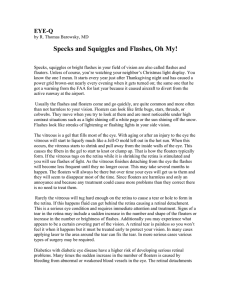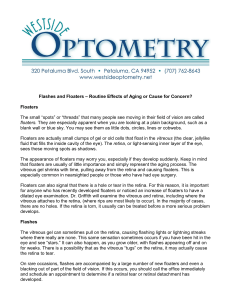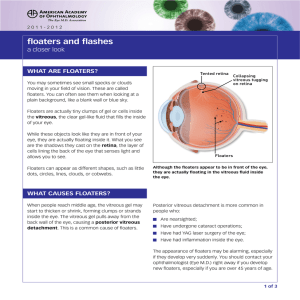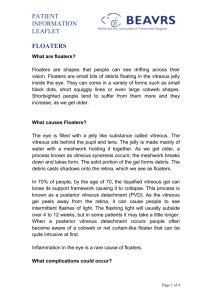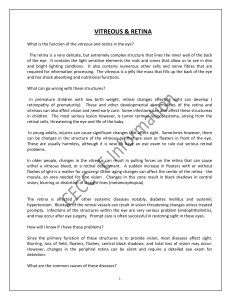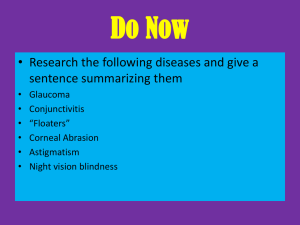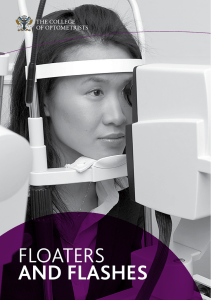Floaters and Flashes - Northern Lincolnshire and Goole NHS
advertisement
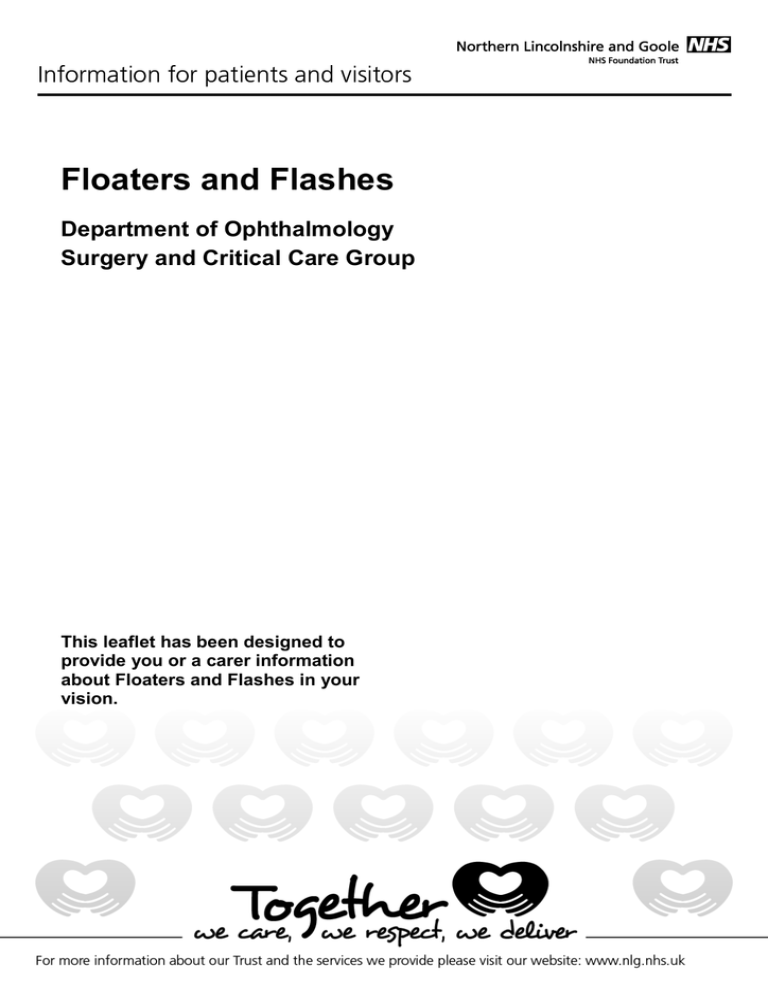
Floaters and Flashes Department of Ophthalmology Surgery and Critical Care Group This leaflet has been designed to provide you or a carer information about Floaters and Flashes in your vision. Introduction This leaflet is to provide you or your carer information about floaters and flashes in your vision. It aims to answer any questions you or your carers may have and to reinforce the information provided by the Doctor in the eye clinic. What are floaters and flashes? Floaters are shapes that drift across your vision. The form of these is variable, they may for example be small dots or irregular shaped strands. Flashes are quick, sudden flashes of light that can happen when the eyes are open or closed. What causes floaters and flashes? The main body of the eye known as the vitreous separates from the retina at the back of the eye, remaining attached at the front of the eye. As it comes away from the retina, the retina is stimulated mechanically and produces the sensation of flashes. Similarly the vitreous separation causes the fine fibrils of the vitreous to come together, and those clumps cause shadows (floaters) which you can see. In addition, the nearer the floater is to the retina the denser the shadow which is cast, so floaters tend to be most troublesome at the beginning. As the vitreous separates from the retina the floaters move away from the retina and the symptoms decrease. The cause of vitreous shrinkage is unknown, although it’s more likely to happen in myopic (short sighted) people and the elderly population. Risks involved with floaters and flashes Generally you should not be concerned about seeing one or two floaters in your vision; almost everyone sees some type of floaters at some point in their lives. Occasionally the symptoms can indicate more than a simple shrinkage of the vitreous. It is possible for the vitreous to be abnormally, strongly attached to the retina, so as the vitreous shrinks; a tear develops in the retina. Sometimes this can lead to retinal detachment. It is therefore important to have the eyes examined to confirm the cause of the floaters is due to vitreous shrinkage. More importantly to examine the retina, looking for holes or even tears is an early sign of retinal detachment. If a tear has developed then laser treatment can be given, to seal the hole. A sudden increase in the number of floaters White flashing lights The appearance of a shadow, like a curtain coming over the vision A cobweb effect appearing in the vision Loss of vision Reference Section Kanski J 2006 Clinical Ophthalmology Butterworth-Heinemann London. Treatment Most symptoms (floaters) settle down on their own, or the person learns to ignore them, with no need for treatment. Contact details for Further Information For further information please discuss with the person providing your care. Alternatives Concerns and Queries A few people do have vitreous surgery for the symptoms, but only if the vision is severely affected. If you have any concerns / queries about any of the services offered by the Trust, in the first instance, please speak to the person providing your care. Vitreous surgery does carry risks and so is only offered when the vision is substantially reduced by the vitreous opacities. If a retinal tear is found with examination, they are usually treated by laser treatment in the outpatient department. In effect the laser "spot welds" the retina surrounding the hole preventing fluid from passing through, holding the retina in place. Points to remember Most people with floaters and flashes need no treatment at all. Once the retina has been thoroughly examined to exclude holes and tears, all that is necessary is that you report any new symptoms that occur, such as: For Diana, Princess of Wales Hospital Alternatively you can contact the Patient Advice and Liaison Service (PALS) on (01472) 875403 or at the PALS office which is situated near the main entrance. For Scunthorpe General Hospital Alternatively you can contact the Patient Advice and Liaison Service (PALS) on (01724) 290132 or at the PALS office which situated on C Floor. Alternatively you can email: nlg-tr.PALS@nhs.net Northern Lincolnshire and Goole NHS Foundation Trust Diana Princess of Wales Hospital Scartho Road Grimsby 01472 874111 Scunthorpe General Hospital Cliff Gardens Scunthorpe 01724 282282 Goole & District Hospital Woodland Avenue Goole 01405 720720 www.nlg.nhs.uk Date of issue: February, 2014 Review Period: February, 2017 Author: CNS Ophthalmology IFP-378 v2.1 © NLGFT 2014
